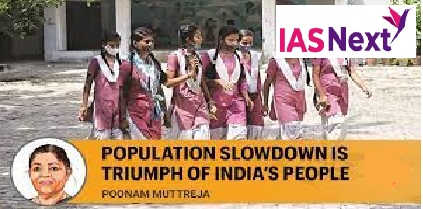CURRENT AFFAIRS
Get the most updated and recent current affair content on Padhaikaro.com
Population Slowdown is Triumph of India’s People
- IAS NEXT, Lucknow
- 01, Dec 2021

Reference News:-
The Ministry of Health and Family Welfare's National Family Health survey (NFHS-5) data on health and family welfare issues has given rise to a flurry of chest-thumping declarations.
What are the survey’s findings about population?
TFR is the average number of children born to a woman during her lifetime whereas Replacement Fertility Rate is the level of fertility at which a population exactly replaces itself from one generation to the next.
- The Total Fertility Rate (TFR) has declined from 2.2 to 2.0 at the national level, even below the replacement rate of 2.1.
- According to the United Nations, if women have on an average 2.1 children each over a sustained period of time, the population neither grows nor declines and thus stabilises.
- The credit for the drop in India’s TFR from almost 6 in the 1950s to its current levels must go to the people of India, along with successive governments, especially the bureaucracy.
- This drop is a sign of changing aspirations, especially among women, who are seeing the wisdom of having fewer children.
What efforts have been taken for population stabilisation?
- India’s family planning programme started in 1951 is among the world’s oldest.
- The campaigns sought to promote smaller families but there was little progress as India continued to see rapid population growth.
- In 1975, the desperation to control the population took a dark turn because a widespread mandatory sterilisation programme saw thousands of vasectomies, many of which were forced.
- These sterilisations became a major issue in the 1977 general elections leading to voting out of Congress government.
- This was the the first time a strong evidence of a clear popular rejection of a coercive population-control policy was witnessed.
- In 1994, at the International Conference on Population Development (ICPD), 179 governments, including India, recognised and committed to a rights-based approach to family planning.
- The ICPD inspired India’s 2000 National Population Policy.
- The implementation picked pace when the National Rural Health Mission, now part of the larger National Health Mission, was launched in 2005.

- The implementation of the provisions of National Population Policy was very slow.
- The burden of family planning stayed with women, with female sterilisation being the most available method.
- Although women desire to have less than two children, there were issues regarding access to family planning services.
- The lack of emphasis on quality of care led to some bad practices where 16 women died in Bilaspur in 2014 after they were sterilised at a government camp.
How the family planning services changed its course?
- In 2016, the Supreme Court in 2016 asked the government to put a stop to sterilisation camps and focus on providing temporary methods of contraception.
- Increased reach of the media has changed women’s aspirations, and their desire for greater control over their lives.
- Girls’ education has a direct co-relation with a decrease in fertility.
- According to NFHS data, women who had no schooling had the highest TFR of 3.06, as compared to women with 12 or more years of education who had a TFR of 1.71.
- The government needs to play a pivotal role and invest in education, health and creating economic opportunities for young people.
- The government must provide health and life-skills education at an early age along with ensuring access to sexual and reproductive health services.